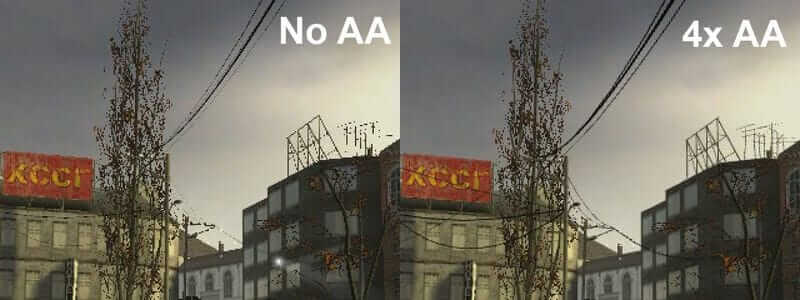Anti Aliasing Fully Explained | What Is It And How Does It Affect While Gaming
If you ever play games on a PC, you probably try to adjust the graphics settings for better fps. During play with settings, you maybe see some settings such as FXAA. MSAA, etc. Well, these are different types of Anti Aliasing. To understand Anti Aliasing, first, we need to know about aliasing.
What Is Aliasing?
Contents
Aliasing is the distortion or jaggies you can see to the edge of any object in the video game. But where these jaggies come from? We know that the images we see on the monitor are made up of millions of tiny square boxes, also known as pixels. As these pixels as square-shaped, it is easy to make horizontal or vertical lines.
But the real-life object has rounded corners. So what happened, if we want to make a diagonal line? That’s where the squares joint with corner to corner to make a diagonal line. As a result, it ended up with a staircase effect that looks so bad.
Anti Aliasing

Anti Aliasing is the technology, used to removes the jaggies from the edges of the object. Therefore it delivers a better graphics experience to the gamer or user.
Now, there is a variety of types of Anti Aliasing such as FXAA, MSAA, SSAA, etc. But all are working with the same concept. Trying to fill the gap with more and more pixels in order to minimize the staircase effect as much as possible.
SSAA
Supersampling Anti Aliasing also called Full Sample Anti Aliasing(FSAA) is the first Anti Aliasing technique come in graphics card. SSAA increases the sample rate meaning that it renders the image with higher resolution.
It is perfect for photorealistic images as it makes them softer but for diagram images, decreases its quality, and makes them more blurry. FSAA goes up to 4x. But if you are running Quadro in SLI it goes up to 16x or even 128x.
Multi-Sampling Anti Aliasing(MSAA)
MSAA works kinda similar to FSAA, but with a little bit different. SSAA supersampling for every single pixel. Typically aliasing noticed on the edges of the polygon, in that case, SSAA is quite unnecessary.
MSAA supersampling the edges of the polygon. The advantage of MSAA is that firstly, Anti-aliased the edges of the polygon in 3D games. Secondly, the pixel shader needs to be evaluated once per pixel.
Fast Approximate Anti Aliasing(FXAA)
FXAA was developed by Timothy Lottes at NVIDIA. To get rid of aliasing, FXAA smoothes the jaggies edges of each pixel on the screen after each pixel is rendered. The most AA technique has to analyze the whole 3D model, whereas FXAA smoothes each pixel individually.
FXAA also includes blended textures and pixel shaders. FXAA does not require a large amount of computing power. The downside of FXAA is that some textures appear soft and it must be applied before rendering the head-up display element in-game.
Not every graphics card supports each technique of AA. But you can download plenty of them. Although it all won’t work as good as a developer implemented. But some of them are advanced than what the developer may have added.
SMAA is a post-processing AA technique using the same method as SSAA of MSAA. SMAA is natively supporting some games and users have seen improvement in visual quality.
Sure! Here’s a fully explained guide to Anti-Aliasing—what it is, how it works, its different types, and how it affects your gaming performance and visuals.
🧠 What Is Anti-Aliasing?
Anti-aliasing (AA) is a graphics technology used to smooth out jagged edges (aliasing) in digital images, especially along curved or diagonal lines. In games, this helps make objects like characters, trees, or roads look cleaner and more natural.
🧱 Why Does Aliasing Happen?
Aliasing happens because digital displays use a grid of square pixels. When diagonal lines are drawn, the edges can appear jagged or stair-stepped—often called “jaggies.”
🎨 How Does Anti-Aliasing Work?
Anti-aliasing blends the colors of edge pixels to smooth transitions between shapes. It simulates softer edges so they look better to the human eye.
🔄 Types of Anti-Aliasing (AA)
| Type | Description | Visual Quality | Performance Impact |
|---|---|---|---|
| SSAA (Super Sampling AA) | Renders at a higher resolution, then downsamples. Best quality. | ⭐⭐⭐⭐⭐ | ❌ Very High |
| MSAA (Multi-Sampling AA) | Applies AA only to polygon edges, not textures. Common in games. | ⭐⭐⭐ | ⚠️ Moderate |
| FXAA (Fast Approximate AA) | Shader-based. Fast, but can blur details. Used in many modern games. | ⭐⭐ | ✅ Very Low |
| TAA (Temporal AA) | Uses frame history to reduce flicker and jaggies. Smooth but blurry. | ⭐⭐⭐⭐ | ⚠️ Moderate |
| DLAA (Deep Learning AA) | AI-enhanced AA (e.g., NVIDIA’s DLAA). Great quality on RTX cards. | ⭐⭐⭐⭐+ | ✅ Efficient (GPU dependent) |
🎮 How Does Anti-Aliasing Affect Gaming?
✅ Pros
- Better Visuals: Smooth, realistic images with less distraction from jagged edges.
- Improved Immersion: Cleaner lines and characters help you stay in the game world.
❌ Cons
- Performance Hit: Some AA methods (like SSAA or MSAA) can drastically lower FPS.
- Blurriness: FXAA and TAA can soften textures or UI elements too much.
- Input Lag: Slight delays may occur in competitive games if AA is too heavy.
🧪 Which Anti-Aliasing Should You Use?
| Your Setup | Recommended AA Type |
|---|---|
| Low-end GPU / Integrated graphics | FXAA or No AA |
| Mid-range GPU | FXAA or TAA (low settings) |
| High-end GPU | TAA or MSAA |
| RTX GPUs | DLAA or TAA with DLSS |
| Competitive Gaming | Prefer no AA for speed |
⚙️ Quick Tips
- Always test different AA settings in your game’s graphics menu.
- Use DLSS (NVIDIA) or FSR (AMD) if supported for performance + visual quality.
- Turning on AA may require balancing with other settings like shadows and resolution.
📸 Visual Example
Imagine a chain-link fence:
- Without AA: Edges of the wires look like zigzag lines.
- With AA: The wires look rounder and more natural, closer to real life.
🧩 Conclusion
Anti-aliasing is crucial for improving image quality in games, especially at lower resolutions. Choosing the right type depends on your hardware power, the game’s support, and your preference between visuals vs. FPS.
Want recommendations for AA settings for a specific game or GPU? Just tell me your setup!
